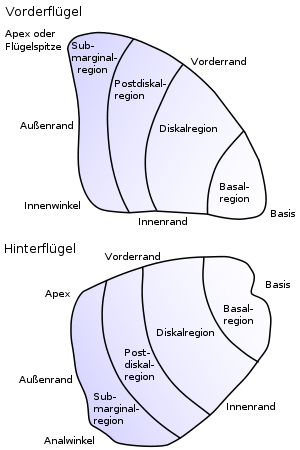Wing (butterfly)

Butterfly wings play an important role in describing and identifying a butterfly . The wing is divided into regions and the veins of the wings and the cells formed from them are numbered.
Regions
To describe butterflies, the front and rear wings of the butterflies are each divided into four areas. The basal region (also basal) is the wing region between the body and the wing center ( disk region ) of the wings. The edge of the wings is called the submarginal region . Between it and the disk region is the post-disk region . For other butterfly families, the division can differ significantly.
Margins
The wings are bounded by the front edge , outer edge and inner edge . The leading edge and outer edge meet in the apex . In the case of the front wing, this is also called the wing tip. The outer edge and the inner edge meet on the forewing in the inner angle , or in the anal angle (tornus) on the rear wing.
Wing veins
The wing veins are particularly important for taxonomy .
Veins
The veins are numbered from 1 to 12 on the front wings, starting from the back with vein 1, which runs parallel to the inner edge and ends at the inner corner.
On the hind wings there are only 9 continuous veins (1a, 1b, 2–8). Sometimes there is also a 10th vein (9), called the precostal vein , which arises at the base and does not extend to the front edge.
However, not all butterflies conform to this scheme, so blues in particular often have only 10 or 11 veins on their forewings. You are then missing up to two of wires 7, 8 or 9.
On the hind wings, parallel to the inner edge, are the anal veins 1a and 1b, whereby the knightly butterflies (Papilionidae) have only one anal vein.
- Forewing
| S. | Subcostal or radial artery |
| D. | Discoid transverse artery |
| M. | Median vein |
| 1 | Submedian vein |
| 12 | Kostalader |
- Hind wings
| S. | Subcostal or radial artery |
| D. | Discoid transverse artery |
| M. | Median vein |
| 1a | Anal vein |
| 1b | Anal vein |
| 8th | Kostalader |
| 9 | Precostal artery |
Many butterflies have a discoid spot on the discoid cross vein, which is used to identify and identify similar species or for typing.
Cells
The areas that are bounded by the veins are called cells. The veins form a conspicuous middle cell , called a cell or discoidal cell for short . From the front it is bounded by the subcostal or radial artery (S), to the outside by the discoidal transverse artery (D) and to the rear by the median artery (M).
The names of the cells follow the name of the wire delimiting below, e.g. B. is the cell 3 above wire 3. Exceptions exist for the wire 1 or the wires 1a and 1b, which are surrounded by the cells 1a and 1b or 1a, 1b and 1c.
swell
- Lionel G. Higgins, Norman D. Rilley: The butterflies of Europe and Northwest Africa (A Field Guide to the Butterflies of Britain and Europe). Paul Parey Publishing House, 1971, ISBN 3-490-02418-4 .
